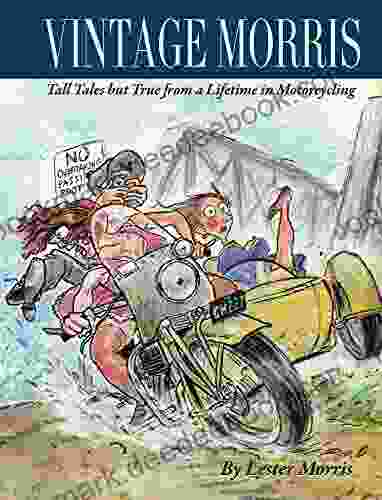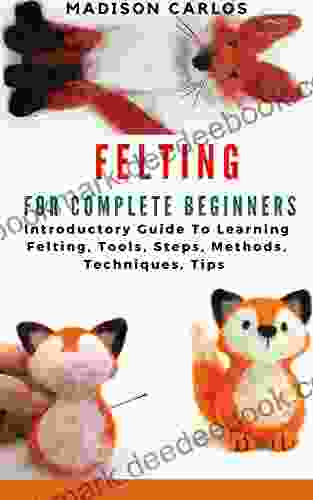Introductory Guide to Learning Felting: Tools, Steps, Methods, Techniques, and Tips

Felting is a versatile and rewarding craft that involves manipulating wool fibers to create unique and beautiful objects. From delicate sculptures to warm and cozy accessories, felting offers endless possibilities for creative expression. Whether you're a complete beginner or looking to expand your felting skills, this comprehensive guide will provide everything you need to get started.
Essential Tools
Before you embark on your felting journey, it's important to gather the necessary tools. Here are some of the most essential items:
5 out of 5
| Language | : | English |
| File size | : | 433 KB |
| Text-to-Speech | : | Enabled |
| Enhanced typesetting | : | Enabled |
| Print length | : | 18 pages |
| Lending | : | Enabled |
| Screen Reader | : | Supported |
- Felting needles: These specialized needles have tiny barbs that hook and tangle wool fibers together. They come in different sizes and shapes, so you can choose the ones that best suit your project.
- Wool roving: Wool roving is the raw material for felting. It comes in a variety of colors and textures, and can be purchased in pre-dyed or natural shades.
- Felting mat: A felting mat provides a firm surface to work on and helps protect your needles from damage.
- Scissors: Sharp scissors are essential for cutting wool roving and shaping your creations.
- Other tools (optional): Depending on your project, you may also find the following tools useful: needle holders, pliers, glue, and embellishments.
Steps to Get Started
Once you have your tools, you're ready to start felting! Here's a step-by-step guide to help you get started:
- Prepare your wool: Separate a small amount of wool roving and roll it into a loose ball. You can also use pre-felted wool if you prefer.
- Stab the wool: Hold the needle perpendicular to the surface of the wool and gently stab it down. Move the needle in a circular motion and repeat until the wool starts to felt.
- Shape the wool: As the wool begins to felt, you can shape it into your desired form by continuing to stab and mold it. Use your fingers or a needle holder to manipulate the fibers.
- Add detail: Once you have the basic shape, you can add details by continuing to felt the wool in specific areas. For example, you could create a nose, eyes, or other features for an animal figure.
- Finish the piece: When you're satisfied with the shape and detail of your creation, you can finish it by gently rubbing the surface with your fingers or a soft cloth. This will help to smooth out any rough edges and give your project a polished look.
Methods and Techniques
There are two main methods of felting: needle felting and wet felting. Needle felting involves using a felting needle to stab and tangle wool fibers together. Wet felting involves using hot, soapy water to agitate wool fibers and cause them to bond.
Needle Felting Techniques
Here are some of the most common needle felting techniques:
- Stabbing: This is the basic technique of needle felting. By repeatedly stabbing the wool fibers with a needle, you can create a solid, cohesive form.
- Rolling: Rolling the wool between your fingers or on a felting mat can help to smooth out the surface and create a more even texture.
- Nuno felting: Nuno felting involves combining wool fibers with a sheer fabric, such as silk or chiffon. This technique can create beautiful, lightweight scarves, wraps, and other items.
Wet Felting Techniques
Here are some of the most common wet felting techniques:
- Fulling: Fulling is a process of agitating wool fibers in hot, soapy water. This causes the fibers to shrink and become more compact, resulting in a denser and more durable fabric.
- Layering: Layering different colors or textures of wool can create interesting patterns and effects. By carefully arranging the wool fibers, you can create unique and visually appealing designs.
- Embellishing: Wet felted items can be embellished with a variety of materials, such as sequins, beads, or embroidery. This can add a personal touch and make your creations even more special.
Tips for Success
Here are some tips to help you succeed in your felting journey:
- Start small: Don't try to tackle a large or complex project right away. Start with something simple and gradually work your way up to more challenging projects.
- Practice regularly: The more you practice, the better you will become at felting. Try to set aside some time each week to practice your skills.
- Be patient: Felting can be a time-consuming process, so don't get discouraged if you don't see results immediately. Be patient and keep practicing, and you will eventually achieve your desired results.
- Experiment with different techniques: Don't be afraid to try different methods and techniques to see what works best for you. There is no right or wrong way to felt, so experiment and find what you enjoy the most.
- Use high-quality materials: The quality of your wool roving will have a significant impact on the final product. Use high-quality wool roving that is clean and free of debris.
- Sharpen your needles: Dull needles will make felting more difficult and can damage your wool. Sharpen your needles regularly to keep them in good condition.
- Safety first: Always wear gloves when using felting needles to protect your fingers from punctures. Never point a needle
5 out of 5
| Language | : | English |
| File size | : | 433 KB |
| Text-to-Speech | : | Enabled |
| Enhanced typesetting | : | Enabled |
| Print length | : | 18 pages |
| Lending | : | Enabled |
| Screen Reader | : | Supported |
Do you want to contribute by writing guest posts on this blog?
Please contact us and send us a resume of previous articles that you have written.
 Novel
Novel Page
Page Chapter
Chapter Story
Story Genre
Genre Reader
Reader Library
Library Magazine
Magazine Newspaper
Newspaper Sentence
Sentence Bookmark
Bookmark Glossary
Glossary Foreword
Foreword Preface
Preface Synopsis
Synopsis Annotation
Annotation Footnote
Footnote Manuscript
Manuscript Scroll
Scroll Bestseller
Bestseller Classics
Classics Narrative
Narrative Biography
Biography Memoir
Memoir Encyclopedia
Encyclopedia Dictionary
Dictionary Thesaurus
Thesaurus Character
Character Catalog
Catalog Card Catalog
Card Catalog Stacks
Stacks Archives
Archives Research
Research Scholarly
Scholarly Lending
Lending Journals
Journals Reading Room
Reading Room Special Collections
Special Collections Study Group
Study Group Book Club
Book Club James O Heare
James O Heare Patti Sheehy
Patti Sheehy Kristen Hopewell
Kristen Hopewell Lee Bacon
Lee Bacon Jennifer Betters Bubon
Jennifer Betters Bubon Laurren Schmoyer
Laurren Schmoyer David L Lightner
David L Lightner Christina E Bejarano
Christina E Bejarano Bonita M Kolb
Bonita M Kolb Carol Ann Martin
Carol Ann Martin Erin Riha
Erin Riha Imogen Matthews
Imogen Matthews Charles A Barone
Charles A Barone Brad Hill
Brad Hill Jeremy Europe
Jeremy Europe Jacqueline L Jackson
Jacqueline L Jackson Ed Sobey
Ed Sobey Gregory Laxer
Gregory Laxer Richard A Nielsen
Richard A Nielsen Joel C Rosenberg
Joel C Rosenberg
Light bulbAdvertise smarter! Our strategic ad space ensures maximum exposure. Reserve your spot today!

 Winston HayesAn Open Letter to the Women Who Will Run the World: Our Future Depends on You
Winston HayesAn Open Letter to the Women Who Will Run the World: Our Future Depends on You
 Arthur C. ClarkeThe Baroque Guitar in Spain and the New World: A Journey Through History and...
Arthur C. ClarkeThe Baroque Guitar in Spain and the New World: A Journey Through History and...
 Anton FosterA Comprehensive Guide to Caring for Your Jenday Conure: Feeding, Grooming,...
Anton FosterA Comprehensive Guide to Caring for Your Jenday Conure: Feeding, Grooming,...
 Edison MitchellOil and Gas Law: A Comprehensive Exploration of the Legal Framework Governing...
Edison MitchellOil and Gas Law: A Comprehensive Exploration of the Legal Framework Governing... Henry GreenFollow ·13.2k
Henry GreenFollow ·13.2k Fernando PessoaFollow ·5.9k
Fernando PessoaFollow ·5.9k Dean ButlerFollow ·15.2k
Dean ButlerFollow ·15.2k George HayesFollow ·14.9k
George HayesFollow ·14.9k Adam HayesFollow ·13.6k
Adam HayesFollow ·13.6k Octavio PazFollow ·7.5k
Octavio PazFollow ·7.5k Bradley DixonFollow ·2.5k
Bradley DixonFollow ·2.5k Cooper BellFollow ·5.3k
Cooper BellFollow ·5.3k

 Oscar Wilde
Oscar WildeDon't Stop Thinking About the Music: Exploring the Power...
Music is an...

 Floyd Richardson
Floyd RichardsonSnowman Story Problems Math With Santa And Friends
It's a cold winter day, and...

 W. Somerset Maugham
W. Somerset MaughamWhat Every Classroom Teacher Needs To Know: A...
Teaching is a challenging...

 Edgar Cox
Edgar CoxTall Tales But True: A Lifetime of Motorcycling...
I've been riding motorcycles for over 50...

 Chinua Achebe
Chinua AchebeBuni: Happiness Is a State of Mind
Buni is a beautiful...

 Herman Melville
Herman MelvilleThe Arts and Crafts of Older Spain: Embodying the Essence...
In the heart of the Iberian...
5 out of 5
| Language | : | English |
| File size | : | 433 KB |
| Text-to-Speech | : | Enabled |
| Enhanced typesetting | : | Enabled |
| Print length | : | 18 pages |
| Lending | : | Enabled |
| Screen Reader | : | Supported |




